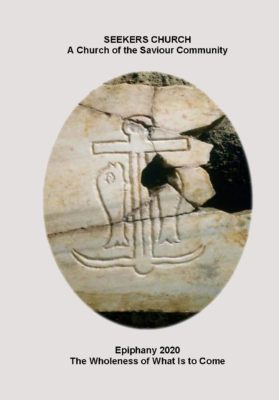
from catacomb of St Priscilla (Rome)
February 23, 2020
Transfiguration
There is a crack in everything
That’s how the light gets in
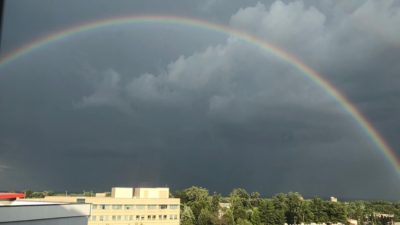 I love that line from the Leonard Cohen song we heard at the beginning of worship. There is a crack in everything and, if we catch it just right, we can see the light of the Divine shine through. That is because the Divine is in everything. And everything is the Divine. That’s what we are learning in Glenn and Kolya’s current School for Christian Growth class on Richard Rohr’s book, The Universal Christ. To me, this picture of a rainbow, taken from my living room window, represents a crack that lets the Divine Light shine through.
I love that line from the Leonard Cohen song we heard at the beginning of worship. There is a crack in everything and, if we catch it just right, we can see the light of the Divine shine through. That is because the Divine is in everything. And everything is the Divine. That’s what we are learning in Glenn and Kolya’s current School for Christian Growth class on Richard Rohr’s book, The Universal Christ. To me, this picture of a rainbow, taken from my living room window, represents a crack that lets the Divine Light shine through.
Another name for the kind of crack that Leonard Cohen is talking about is “thin place.” The poet Sharlande Sledge says of thin spaces:
“Thin places,” the Celts call this space,
Both seen and unseen,
Where the door between the world
And the next is cracked open for a moment
And the light is not all on the other side.
God shaped space. Holy.
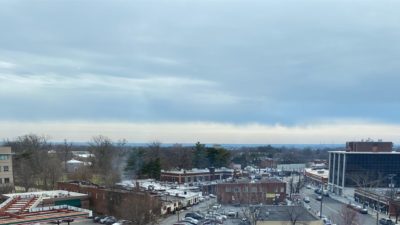 For me, the sky. as viewed from my living room window, is a thin place.
For me, the sky. as viewed from my living room window, is a thin place.
My building faces southeast and every morning I go to my living room window and, look out at the sky. I try to remember to say: “Thank you, God, for this new day,” because I want to remember each day how grateful I am to be living, perceiving, and conscious. The view from my window is interesting, though mostly rather ordinary: streets and sidewalks, a lot of cars, a 7/11, the backs and fronts of buildings and stores, a 7/11. Look at the sky, though. Isn’t it beautiful?
 The morning is such a wonderful time to catch a glimpse of the Divine because, on days that aren’t too cloudy or clear, I can see the sun breaking through the clouds in a glorious display of light. Some of the many skies I’ve seen from my living room window are captured in the pictures I am showing you here today.
The morning is such a wonderful time to catch a glimpse of the Divine because, on days that aren’t too cloudy or clear, I can see the sun breaking through the clouds in a glorious display of light. Some of the many skies I’ve seen from my living room window are captured in the pictures I am showing you here today.
 Today is Transfiguration Sunday. On this last Sunday before Lent, we celebrate the transfiguration of Jesus. On this occasion, Jesus took Peter, James, and John up a mountain and they saw Jesus’ face shine like the sun and his clothes glow with a dazzling whiteness.
Today is Transfiguration Sunday. On this last Sunday before Lent, we celebrate the transfiguration of Jesus. On this occasion, Jesus took Peter, James, and John up a mountain and they saw Jesus’ face shine like the sun and his clothes glow with a dazzling whiteness.
 Moses and Elijah were there, having materialized right out of the Old Testament. And God’s voice thundered from a bright cloud, saying, “This is my Son, the Beloved…listen to him.”
Moses and Elijah were there, having materialized right out of the Old Testament. And God’s voice thundered from a bright cloud, saying, “This is my Son, the Beloved…listen to him.”
 One of the things I love most about this story is Peter’s response. I identify with him because so often he just plain doesn’t get it. Just like me. Peter is so impressed by Jesus’ transfiguration and the appearance of the ancient prophets that he is all set to build houses for all three of them: Jesus, Moses, and Elijah. I think he imagines himself, James, and John living up there, too—perhaps in tents, in blessed communion with these manifestations of the Divine. Always in the light.
One of the things I love most about this story is Peter’s response. I identify with him because so often he just plain doesn’t get it. Just like me. Peter is so impressed by Jesus’ transfiguration and the appearance of the ancient prophets that he is all set to build houses for all three of them: Jesus, Moses, and Elijah. I think he imagines himself, James, and John living up there, too—perhaps in tents, in blessed communion with these manifestations of the Divine. Always in the light.
 The word “transfiguration” refers to “an exalting, glorifying, or spiritual change.”
The word “transfiguration” refers to “an exalting, glorifying, or spiritual change.”
The ordinary is transformed into the miraculous. But the ordinary is still there. Like Paul, when we catch a glimpse of the Divine, we want to stay there, build houses and temples around it, start an institute, bask in it forever. But it doesn’t work that way. We can follow practices that increase the likelihood we’ll catch these glimpses, or remember them, but we can’t put the Divine Light in a ventilated jar like a cluster of fireflies that we carry around in the dark to light our way. Often, we can’t even nail down what we saw with our words. Death and resurrection are occurring constantly—everything changes. Rohr calls these two processes “love” and “suffering.”
 But the Divine is always there, in everything, whether we see it or not, says Richard Rohr. And everything is the Divine. David Steindl-Rast, a Benedictine monk who, like Rohr, has studied many different religions, says:
But the Divine is always there, in everything, whether we see it or not, says Richard Rohr. And everything is the Divine. David Steindl-Rast, a Benedictine monk who, like Rohr, has studied many different religions, says:
A lifetime may not be long enough to attune ourselves fully to the harmony of the universe. But just to become aware that we can resonate with it—that alone can be like waking up from a dream.
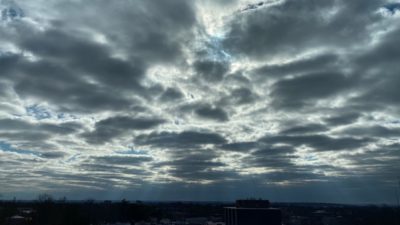 To Rohr, the term “Universal Christ” is one name among many for the light (or love) of the Divine that we catch glimpses of in thin places or through the cracks. He uses the follow terms to describe it.
To Rohr, the term “Universal Christ” is one name among many for the light (or love) of the Divine that we catch glimpses of in thin places or through the cracks. He uses the follow terms to describe it.
- “the transcendent within: of everything in the universe…”
- “the immense spaciousness of all true Love”
- “an infinite horizon that pulls us from within and pulls us forward, too”
- “another name for everything—in its fullness”
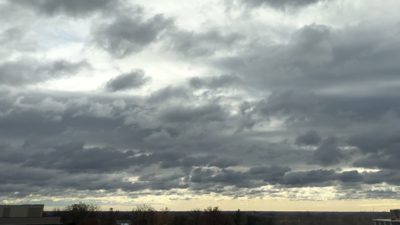 It’s very mysterious and hard to grasp with our intellect. Rohr calls his mystical perspective, the “Big Tradition.” Spirituality of this sort has also been called the “Perennial Tradition,” meaning that it views all the world’s religious traditions as sharing a single, metaphysical truth. That truth is Divine Love, or the light we see through veils and cracks.
It’s very mysterious and hard to grasp with our intellect. Rohr calls his mystical perspective, the “Big Tradition.” Spirituality of this sort has also been called the “Perennial Tradition,” meaning that it views all the world’s religious traditions as sharing a single, metaphysical truth. That truth is Divine Love, or the light we see through veils and cracks.
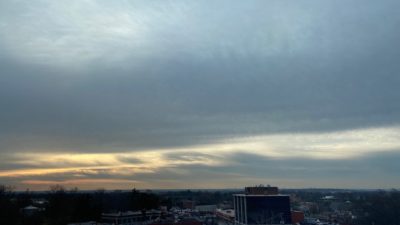 He says that “only great (Divine) love and great suffering are strong enough to take away our imperial ego’s protections and open us to authentic experiences of transcendence.” In other words, we are so attached to our ego, which both protects and constricts us, that it takes an experience of great suffering and redemptive love for us to begin to let go of our ego and its ingrained ways of perceiving and open ourselves to the experience of the Divine. Our ego lets go in times of great suffering because we recognize that our ego is useless, that we are powerless over our suffering, and when we recognize that, we are able to open ourselves to Divine love.
He says that “only great (Divine) love and great suffering are strong enough to take away our imperial ego’s protections and open us to authentic experiences of transcendence.” In other words, we are so attached to our ego, which both protects and constricts us, that it takes an experience of great suffering and redemptive love for us to begin to let go of our ego and its ingrained ways of perceiving and open ourselves to the experience of the Divine. Our ego lets go in times of great suffering because we recognize that our ego is useless, that we are powerless over our suffering, and when we recognize that, we are able to open ourselves to Divine love.
 Rohr has studied many spiritual traditions, including the spirituality inherent in 12-Step programs such as Alcoholics Anonymous. He resonates with the 12-Step perspective on suffering (in AA, people talk about “hitting bottom” before “seeing the light”).
Rohr has studied many spiritual traditions, including the spirituality inherent in 12-Step programs such as Alcoholics Anonymous. He resonates with the 12-Step perspective on suffering (in AA, people talk about “hitting bottom” before “seeing the light”).
As we begin the transition to Lent, Rohr’s teachings are especially appropriate because Lent is a dark time—a time of suffering.
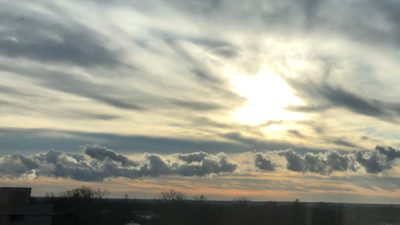 In one of his daily meditations, Rohr says: “Pain teaches a most counterintuitive thing—that we must go down before we even know what up is. In terms of the ego, most religions teach in some way that all of us must die before we die, and then we will not be afraid of dying. Suffering of some sort seems to be the only thing strong enough to destabilize our arrogance and our ignorance. I would define suffering very simply as whenever you are not in control…
In one of his daily meditations, Rohr says: “Pain teaches a most counterintuitive thing—that we must go down before we even know what up is. In terms of the ego, most religions teach in some way that all of us must die before we die, and then we will not be afraid of dying. Suffering of some sort seems to be the only thing strong enough to destabilize our arrogance and our ignorance. I would define suffering very simply as whenever you are not in control…
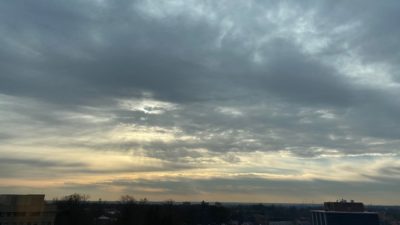 If there isn’t some way to find some deeper meaning to our suffering, Rohr says, to find that God is somewhere in it, and can even use it for good, we will normally close up and close down. “The natural movement of the ego is to protect itself so as not to be hurt again. The soul does not need answers, it just wants meaning, and then it can live. Surprisingly, suffering itself often brings deep meaning to the surface to those who are suffering and also to those who love them.”
If there isn’t some way to find some deeper meaning to our suffering, Rohr says, to find that God is somewhere in it, and can even use it for good, we will normally close up and close down. “The natural movement of the ego is to protect itself so as not to be hurt again. The soul does not need answers, it just wants meaning, and then it can live. Surprisingly, suffering itself often brings deep meaning to the surface to those who are suffering and also to those who love them.”
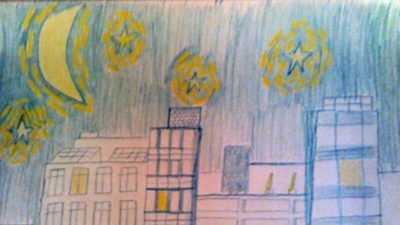 I want to tell you about an experience of mine that caused me great suffering but also great love and many glimpses of the Divine Light. About 7 years ago, my son, Eric, was diagnosed with leukemia. He was 40 at the time. He received his initial chemotherapy here, at Holy Cross, but then was referred up to Johns Hopkins, in Baltimore, for more intensive and specialized chemotherapy. I got up there to see him as often as I could, but he spent most of his time alone. He was sick and in a lot of pain and he must have been frightened, but, sick as he was, he drew this inspiring picture of the view from his window. Eric, as an adult, was not a highly cheerful person. In fact, he was rather sardonic. But this picture indicates to me that, at some point in his lonely hospital stay, he got a glimpse of the Divine.
I want to tell you about an experience of mine that caused me great suffering but also great love and many glimpses of the Divine Light. About 7 years ago, my son, Eric, was diagnosed with leukemia. He was 40 at the time. He received his initial chemotherapy here, at Holy Cross, but then was referred up to Johns Hopkins, in Baltimore, for more intensive and specialized chemotherapy. I got up there to see him as often as I could, but he spent most of his time alone. He was sick and in a lot of pain and he must have been frightened, but, sick as he was, he drew this inspiring picture of the view from his window. Eric, as an adult, was not a highly cheerful person. In fact, he was rather sardonic. But this picture indicates to me that, at some point in his lonely hospital stay, he got a glimpse of the Divine.
Eric came home for a while, but after this round of chemotherapy, it was decided that he was going to need a bone marrow transplant. I was a match, so I donated the bone marrow. He would need daily treatment and care during the bone marrow transplant period, so we moved up to Baltimore for 2 ½ months and, when he was not in the hospital, stayed in a short-term housing unit next to the hospital with other cancer patients and their families. I made the decision, before we moved up there, to treat this as a spiritual retreat. I read a lot, painted a lot, and prayed a lot. The main book that I read was a book by Barbara Brown Taylor called Learning to Walk in the Dark, which I highly recommend. The main theme for my contemplations was darkness and light.
I kept a journal and sent daily entries to Marjory Bankson, my spiritual director, who faithfully sent daily comments back to me. Great suffering and great love, as Rohr would point out.
 Marjory’s walking beside me in the dark was one glimpse I was given of the great love of the Divine in the midst of suffering. But there were many others. Here’s one of them. To get to the unit where Eric received his treatments, we walked (or I wheeled him in a wheelchair, depending on how he felt) through the garage, which was connected to where we were living, then across a bridge that straddled a busy road, and into the hospital. The bridge was a study in light. There were flecks of glittering mica in the floor tiles and the ceiling lights reflected down onto the floor. You can see, also, that there was a bright light at the end of the bridge, coming from the hospital. And at night, all of the lights of Baltimore flickered through the glass walls of the bridge, along with the headlights and taillights of the cars below.
Marjory’s walking beside me in the dark was one glimpse I was given of the great love of the Divine in the midst of suffering. But there were many others. Here’s one of them. To get to the unit where Eric received his treatments, we walked (or I wheeled him in a wheelchair, depending on how he felt) through the garage, which was connected to where we were living, then across a bridge that straddled a busy road, and into the hospital. The bridge was a study in light. There were flecks of glittering mica in the floor tiles and the ceiling lights reflected down onto the floor. You can see, also, that there was a bright light at the end of the bridge, coming from the hospital. And at night, all of the lights of Baltimore flickered through the glass walls of the bridge, along with the headlights and taillights of the cars below.
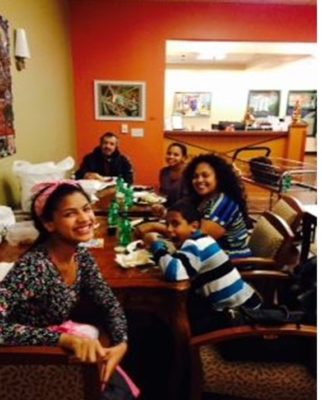 Here’s another glimpse of Divine Light: the Christmas dinner my daughter brought that we all ate together in the Hackerman-Patz Pavilion: My daughter, Sara, my three grandchildren, and Eric down at the end of the table.
Here’s another glimpse of Divine Light: the Christmas dinner my daughter brought that we all ate together in the Hackerman-Patz Pavilion: My daughter, Sara, my three grandchildren, and Eric down at the end of the table.
Eric did die, in spite of the bone marrow transplant. But he did not die afraid—he was ready to go. He taught me a great deal about dying and the whole experience taught me much about suffering and love and finding light in darkness.
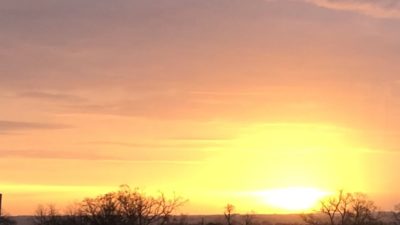 I have continued to share my thoughts on light in darkness in my Mission Group, both in my spiritual reports to Marjory, and in our individual sharing time with the group as a whole. Also in occasional sermons here at Seekers. My Mission Group is Learners and Teachers and reading Rohr for the Universal Christ class has caused me to think of my Mission Groups as one of the cracks that lets the light come in. Not just for members of the Mission Group itself, but for all of the people who take classes in the School for Christian Growth.
I have continued to share my thoughts on light in darkness in my Mission Group, both in my spiritual reports to Marjory, and in our individual sharing time with the group as a whole. Also in occasional sermons here at Seekers. My Mission Group is Learners and Teachers and reading Rohr for the Universal Christ class has caused me to think of my Mission Groups as one of the cracks that lets the light come in. Not just for members of the Mission Group itself, but for all of the people who take classes in the School for Christian Growth.
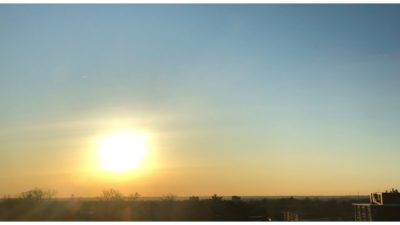 The Seekers website describes a mission group as follows:
The Seekers website describes a mission group as follows:
A mission group is a place where you can join with a few others who share a commitment to God’s call on their lives to do some particular kind of transforming work in the world. A mission group is a place of safety in which you can share your inner journey, find forgiveness and understanding, ask and answer hard questions, and discern ever more clearly the ways in which God is calling you to embody Christ in your daily life. A mission group is a place where you can find support and encouragement for your spiritual growth while engaged in a particular work of transforming service. A mission group is a place where both your journey inward to knowing God and your journey outward to service can be held together in loving community.
This formal statement doesn’t mention one of the most fun things about Mission Groups: when you are connected to the same people in a group over time, you receive another Divine gift That gift is something I would call Divine laughter. Divine laughter is possible when there is enough trust in others and enough letting go of ego that we can laugh together at ourselves and our shared human condition. We do a lot of laughing in my mission group.
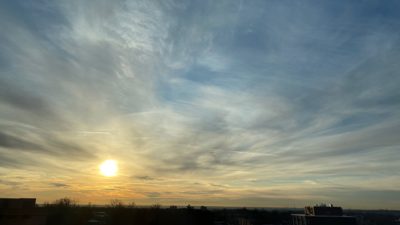 The Learners and Teachers Mission Group is responsible for the School for Christian Growth, which sponsors Christian education and spiritual growth classes for the Seekers community. The School for Christian Growth, according to its statement on the Seekers website: “introduces newcomers into the life and faith of this community; supports the structures of Seekers Church that move individuals into deeper levels of intentional commitment; and enriches and deepens the understanding and spiritual development of participants at all stages of their faith journeys.”
The Learners and Teachers Mission Group is responsible for the School for Christian Growth, which sponsors Christian education and spiritual growth classes for the Seekers community. The School for Christian Growth, according to its statement on the Seekers website: “introduces newcomers into the life and faith of this community; supports the structures of Seekers Church that move individuals into deeper levels of intentional commitment; and enriches and deepens the understanding and spiritual development of participants at all stages of their faith journeys.”
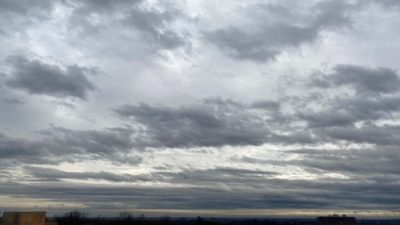 Our mission group meets weekly, on Tuesdays, and is, for me, a reliable source of emotional support as well as spiritual growth. In addition, it gives me a way of committing myself to service. The meals we share with those taking the classes before class on Tuesday nights provide nourishment and fellowship in equal measure.
Our mission group meets weekly, on Tuesdays, and is, for me, a reliable source of emotional support as well as spiritual growth. In addition, it gives me a way of committing myself to service. The meals we share with those taking the classes before class on Tuesday nights provide nourishment and fellowship in equal measure.
 Periodically, Mission Groups issue a call for new members. I want to end my sermon today by issuing such a call on behalf of Learners and Teachers. We are ready to welcome some new members. We invite you to talk to any one of us if you feel drawn to this Mission Group and the work it does. Our members are David Lloyd, Marjory Bankson, John Morris, Marcia Sprague, and me. If you are moved to proceed after you have talked it over with one or more of us, David Lloyd, our moderator, will invite you to visit the group for a trial period of participation during which you can explore your call to join the group.
Periodically, Mission Groups issue a call for new members. I want to end my sermon today by issuing such a call on behalf of Learners and Teachers. We are ready to welcome some new members. We invite you to talk to any one of us if you feel drawn to this Mission Group and the work it does. Our members are David Lloyd, Marjory Bankson, John Morris, Marcia Sprague, and me. If you are moved to proceed after you have talked it over with one or more of us, David Lloyd, our moderator, will invite you to visit the group for a trial period of participation during which you can explore your call to join the group.
If you are not currently in a Mission Group, you are missing a very special opportunity to belong to a loving community within a community. I experience my Learners and Teachers Mission Group as a thin place, as holy ground. And I firmly believe, as I said before, that the classes we organize, create some thin places, or cracks, that let the light get in.